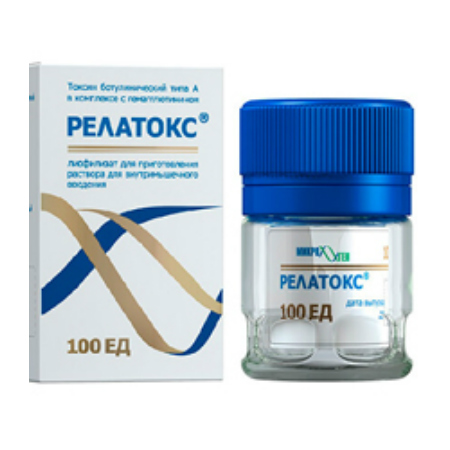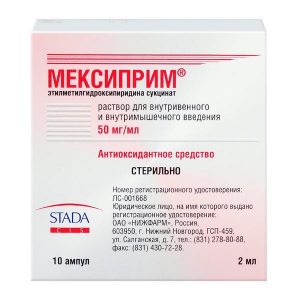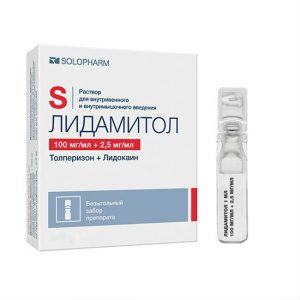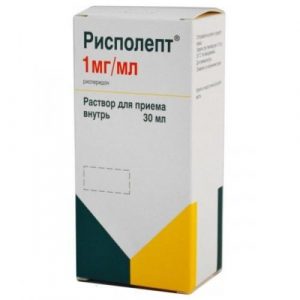Description
Release form
Lyophilisate for preparation of solution for intramuscular injection rdld rdlp2929
Packing
1 fl.
Pharmacological action
ATX code: M03AX01
Pharmacological properties of
Pharmacodynamics
The type A botulinum toxin molecule consists of a heavy (with a molecular weight of 100,000 daltons) and light (with a molecular weight of 50,000 daltons) chains linked by a disulfide bridge. The heavy chain has a high binding affinity for specific receptors located on the surface of target neurons. The light chain has a Zn2 + -dependent protease activity specific for the cytoplasmic regions of a synaptosomal-bound protein having a molecular weight of 25,000 daltons (SNAP-25) and participating in exocytosis processes. The first stage of the action of botulinum toxin type A is the specific binding of the molecule to the presynaptic membrane. The second stage is the penetration of the bound toxin into the cytosol of the nerve through endocytosis. The intracellular light chain acts as a Zn2 + -dependent pitosol protease. selectively cleaving SNAP-25, which in the third stage leads to blockade of the release of acetylcholine from presynaptic terminals of cholinergic neurons. The final effect of this process is persistent chemo-denervation.
When administered intramuscularly, 2 effects develop: direct inhibition of extrafusal muscle fibers by inhibiting alpha-motor neurons at the level of the neuromuscular synapse and inhibition of muscle spindle activity by inhibiting the gamma-motor neuron cholinergic synapse on the intrafusal fiber. A decrease in gamma activity leads to a relaxation of the intrafusal fibers of the muscle spindle and reduces the activity of Ia afferent nerve fibers. This leads to a decrease in the activity of muscle stretch receptors, as well as the efferent activity of alpha and gamma motor neurons. Clinically, this is manifested by pronounced relaxation of the injected muscles and a significant reduction in pain in them. Along with the denervation process, reinnervation proceeds in these muscles by the appearance of lateral processes of nerve endings, which leads to the restoration of muscle contractions 4-6 months after injection.
Pharmacokinetics
A pharmacological effect develops at the injection site. Presynaptic capture and retrograde axonal transport from the injection site is negligible.
Duration of clinical effect is 4-6 months. The restoration of neuromuscular activity occurs due to the development of new axonal processes that form new functional active neuromuscular synapses, which ultimately leads to the restoration of muscle contractions.
When administered in therapeutic doses, Relatox ® does not cross the blood-brain barrier and does not cause significant systemic effects. It is excreted by the kidneys in the form of non-toxic metabolites.
Antibodies to the complex of botulinum toxin type A with hemagglutinin are formed in 1-5% of patients after repeated injections. The formation of antibodies is facilitated by the administration of the drug in high doses and repeated injections in small doses at short intervals. In the case of the formation of antibodies to botulinum toxin type A, the effect of the subsequent reaction can be reduced.
Indications
Treatment of blepharospasm, spasticity of the muscles of the upper limb after an ischemic stroke, correction of hyperkinetic folds of the face (facial wrinkles) in adults.
Treatment of spasticity of the upper and lower extremities in children 13-17 years old with cerebral palsy.
Contraindications
Age 13 years old
inflammation at the site of the alleged injection
acute phase of infectious diseases
severe gravitational ptosis of the facial tissues
severe hernias in the upper and lower eyelids
the sensitivity of the surgery less than 3 months after s surgery increased the components of the drug.
Use during pregnancy and lactation
Contraindicated in pregnancy and lactation.
Composition
1 vial with powder 400 mg 40 pflit a bottle with Relatox ® preparation contains: a complex of botulinum toxin type A with hemagglutinin – 50 PIECES or 100 PIECES of
gelatin – 6 mg
maltose – 12 mg.
Dosage and administration
Before diluting the drug, the central part of the cork of the vial is treated with ethyl alcohol. The drug is dissolved by introducing into the vial 1-8 ml of a 0.9% sodium chloride solution for injection by puncturing the stopper with a sterile needle 23 or 25 mm long. It is forbidden to open a bottle and remove a stopper. The solution of the drug is a clear, colorless liquid.
The prepared injection solution is injected with an insulin syringe with a fixed needle with a diameter of 0.27-0.29 mm. The position of the patient with the introduction of the drug into the muscles of the face – sitting on a chair, the back of the head is fixed.
Side effects
The frequency of adverse reactions is presented for each indication for the use of the drug based on clinical experience. The frequency is indicated according to the recommendations of the World Health Organization and includes the following categories: very often (> 1/10) often (> 1/100 and <1/10), infrequently (> 1/1000 to <1/100), rarely (> 1/10000 and <1/1000), very rarely (<1/10000, including individual cases). In the treatment of blepharospasm and correction of hyperkinetic folds of the face (facial wrinkles). Disorders at the injection site: Often: pain at the injection site, irritation and swelling, tightening, erythema, tightness of the skin, hyperemia at the injection site. Infrequently: microhematomas, ecchymoses, point keratitis. Very rare: diffuse hyperemia. General disorders: Rarely: systemic reactions in the form of general weakness and a short-term increase in body temperature to subfebrile numbers (up to 37.5 ° C). Disorders of the nervous system: Infrequently: asymmetry of the corners of the mouth. Rarely: headache, dizziness, drowsiness. Very rare: difficulty closing the eyelids, lagophthalmos, paresis of facial muscles, paralysis of facial muscles, impaired articulation, numbness of the lips. Violation of the organ of vision: Very rarely: impaired accommodation, dry eyes, photophobia and increased lacrimation. Digestive Disorder: Rarely: nausea. Violations of the musculoskeletal and connective tissue: Very rarely: omission of the interbrow region, lateral areas of the eyebrows, ptosis. In the treatment of spasticity of the muscles of the upper limb after ischemic stroke. Disorders at the injection site: Very often: pain, swelling, skin irritation at the injection site. Infrequently: hemorrhage at the injection site. Disorders of the skin and subcutaneous fat: Infrequently: skin itching. Violations of the musculoskeletal and connective tissue: Often: muscle weakness. Infrequently: arthralgia, pain in the limb. Disorders of the nervous system: Often: headache, dizziness. Infrequently: hypesthesia, paresthesia. Rarely: impaired coordination. Digestive Disorder: Rarely: nausea. Mental disorders: Often: insomnia. If the procedure is performed by an unqualified person, needle injuries of vital structures (nerves, vessels) are possible. In the treatment of spasticity of the muscles of the upper and lower extremities in cerebral palsy. General disorders: Rarely: hyperthermia up to 37.1 ° C. Disorders at the injection site: Very often: pain, skin irritation at the injection site. Infrequently: swelling, hemorrhage at the injection site. Disorders of the skin and subcutaneous fat: Infrequently: skin itching. Disorders of the musculoskeletal and connective tissue: Often: muscle weakness. Infrequently: arthralgia, pain in the limbs. Disorders of the nervous system: Often: headache. Infrequently: hyposthesia, paresthesia. Rarely: impaired coordination, dizziness. Disorders of the organ of vision: Rarely: ophthalmoplegic syndrome. Disorders of the cardiovascular system: Rarely: orthostatic hypotension. Digestive Disorder: Rarely: nausea. Mental disorders: Rarely: insomnia, depression. If the procedure is performed by an unqualified person, needle injuries of vital structures (nerves, vessels) are possible. Drug Interaction The effect of the drug is enhanced by the simultaneous use of antibiotics of the group of aminoglycosides, erythromycin, tetracycline, polymyxins, agents that reduce neuromuscular transmission (including non-depolarizing). Overdose Patients with symptoms of botulinum toxin A poisoning (general weakness, ptosis, diplopia, difficulty in swallowing and disorders of speech, paresis of respiratory muscles) should be hospitalized. Intubation and transfer to artificial lung ventilation is necessary for respiratory muscle paralysis to improve the patient’s condition. Storage conditions Store and transport in accordance with SP 3.3.2.3332-16 at a temperature of 2 to 8 ° C in a separate, closed, marked packet. Keep out of the reach of children. Expiration 2 years. Terms of delivery from pharmacies Prescription




